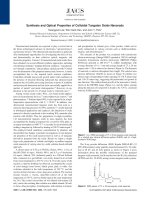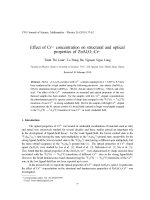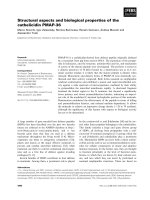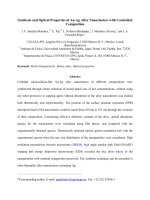Electrical and optical properties of the hybrid TiO2 nanocrystals – meh-PPV thin films
Bạn đang xem bản rút gọn của tài liệu. Xem và tải ngay bản đầy đủ của tài liệu tại đây (317.49 KB, 6 trang )
Communications in Physics, Vol. 19, No. 4 (2009), pp. 243-248
ELECTRICAL AND OPTICAL PROPERTIES OF THE HYBRID
TiO2 NANOCRYSTALS – MEH-PPV THIN FILMS
LE HA CHI, NGUYEN NANG DINH, PHAN THI QUE ANH
College of Technology, Vietnam National University, Hanoi
PHAM DUY LONG
Institute of Materials Science, VAST
DANG TRAN CHIEN
Hanoi College of Natural Resources and Environment
TRAN THI CHUNG THUY
Thai Nguyen University, Thai Nguyen
Abstract. Recently, the conjugated polymer – inorganic nanocomposites have been increasingly
studied because of their enhanced optical and electronic properties as well as their potential application in developing optoelectronic devices. In this study nanocomposite materials thin films based
on poly [2-methoxy-5-(2’-ethyl-hexyloxy)-1,4-phenylene vinylene] (MEH-PPV) and nanocrystalline
TiO2 (nc-TiO2 ) have been fabricated. The photoluminescence (PL) spectra of pure MEH-PPV and
nanohybrid films have shown that the excitation at a 377 nm wavelength leads to the strongly enhanced performance in photoluminescent intensity due to the compositions of TiO2 component.
Current-voltage (I-V) characteristics of multi-layer device Al//MEH-PPV:nc-TiO2 //PEDOT:
PSS//ITO//glass were investigated. The results show that the hybrid MEH-PPV:nc-TiO2 materials with high concentrations of TiO2 (> 25%) can be expected to be a good candidate for photovoltaic solar cell applications whereas those with lower concentrations of TiO2 are more suitable
for organic light-emitting diodes (OLEDs).
I. INTRODUCTION
Over the last decade, conjugated polymers have attracted great interest due to
most of the polymers can be processed from solution at room temperature and their potential application in developing large scopes, flexible, lightweight and low cost organic
light emitting diodes (OLEDs) and organic solar cells (OSCs) [1,2]. Unfortunately, the
electrical and optical properties of these polymers do not compare to those of inorganic
semiconductor materials, thus, polymer-based devices have performed poorly in common.
In recent years, incorporation of semiconductor nano-particles in an polymer matrix has
been increasingly studied and has opened up the potential to improve the performance of
these devices. Hybrid organic–inorganic materials can combine the advantages of the film
forming properties of polymers with those of the unique properties of inorganic nanoparticles. In this work, the nanocomposite thin films based on poly [2-methoxy-5-(2’-ethylhexyloxy)-1,4-phenylene vinylene] (MEH-PPV) and nanocrystalline TiO2 (nc-TiO2 ) have
been fabricated. Enhanced performance in these optical and electrical properties of that
nanohybrid material depending on the compositions of nc-TiO2 was investigated.
244
LE HA CHI et al.
II. EXPERIMENTAL
MEH-PPV solution was prepared by dissolving MEH-PPV powder (product of
Aldrich, USA) in chloroform with a ratio as 2 mg of MEH-PPV in 1 ml of chloroform. The
hybrid organic–inorganic materials based on MEH-PPV and nc-TiO2 have been fabricated
by dispersing 5 nm TiO2 powder (product of Aldrich, USA) with various ratios (10, 25
and 50 wt% relative to MEH-PPV) in as-prepared MEH-PPV solution.
The device with structure of Al//MEH-PPV:nc-TiO2 //PEDOT:PSS//ITO//glass
was fabricated as following procedure. The optically transparent and electrically conductive indium tin oxide (ITO) coated glass substrate with a sheet resistance of 30Ω/
was ultrasonically cleaned in a series of solvents (ethanol, aceton and deionized water).
A hole injection buffer layer of polyethylenedioxy-thiophene : polystyrene sulfonate (PEDOT:PSS) was spin-coated on the ITO substrate at spin rates ranging of 2000 rpm for
60 s. Then the pristine MEH-PPV or the MEH-PPV blended with nc-TiO2 (10, 25 and
50 wt% relative to MEH-PPV) was spin-coated on the top of PEDOT:PSS thin film layer.
The spin coating was carried-out in gaseous nitrogen with a set-up procedure as follow.
The delay time is 120 s, the spin speed is 1500 rpm, the acceleration time is 20 s and the
relaxation time is 5 min. The thickness of the polymer layer is controlled both by spin
speed and by the concentration of polymer in the solvent. After spin-coating the samples
were put into a vacuum oven for removing the solvent from the polymer film at 150o C in
a vacuum of 10−3 torr for 2 hours. For current-voltage (I-V) testing, an aluminum alloy
layer was vacuum deposited by thermal evaporation on the hybrid film to complete the
device.
The surface morphology of samples was investigated by using a “Hitachi” Field
Emission Scanning Electron Microscopy (FE-SEM) S-4800. The thickness of all thin films
was examined by an alpha step surface profile monitor. The Ultraviolet–visible (UV–
vis) absorption spectra was performed by using a Jasco UV-VIS-NIR V570 spectrometer.
Photoluminescence (PL) spectra were carried-out by using a FL3-2 spectrophotometer and
current-voltage (I-V) characteristics were measured on an Auto-Lab Potentiostat PGS-30.
III. RESULTS AND DISCUSSION
III.1. Morphology of the hybrid TiO2 nanocrystals – MEH-PPV thin film
As shown in Fig. 1a, homogeneous MEH-PPV film with good quality deposited
onto glass substrate from MEH-PPV solution exhibited smooth surface and good film-tosubstrate adhesion. On the other hand, it was shown that the TiO2 nanoparticles became
large-sized and agglomerated in the composite films as the percentage of TiO2 increases,
which resulted in more highly interpenetrated networks of TiO2 produced at higher concentrations. Some large clusters were observed in case of the highest concentration of
nc-TiO2 (50 wt%) in MEH-PPV hybrid films, as seen in Fig. 1b.
Photoluminescence of polymeric composites
Fig. 2 shows the absorption spectra (a) and photoluminescence spectra (b) excited
at a short wavelength (λ = 377 nm) of the MEH-PPV and the hybrid MEH-PPV:nc-TiO2
respectively. The absorption spectrum of the pristine polymer MEH-PPV shows a peak
ELECTRICAL AND OPTICAL PROPERTIES OF THE HYBRID TiO2 ...
245
Fig. 1. FE-SEM photographs of the MEH-PPV thin film (a) and the hybrid
nc-TiO2 (50wt%) – MEH-PPV thin film (b).
at 490 nm. The broad band peaked at 490 nm is ascribed to the π–π* transitions of
the conjugated polymer as shown in [3]. Fig. 2(a) reveals that with addition of TiO2
nanocrystals the absorption peak of MEH-PPV shifts to shorter wavelengths and the
optical density of the absorption spectra in the hybrid films increases with respect to
the pristine polymer. The observed results might be explained as the absorption of the
composite that has increased compared to the pure MEH-PPV due to the absorption of
nanocrystal TiO2 at wavelengths lower than 400 nm. In addition, the amount of TiO2
increasing from 10% to 50% in the hybrid materials results in the increasing number of
interfaces between the two materials. The embedding of TiO2 in polymer matrix prevents
the formation of polymer aggregates in the composite films and reduces the polymer
conjugation chain length of MEH-PPV, therefore shifted the peak [4,5].
Absorbance [a. u.]
300
400
500
600
Wavelength [nm]
700
800
MeH-PPV
MeH-PPV:TiO2(10%)
MeH-PPV:TiO2(25%)
MeH-PPV:TiO2(50%)
(b)
PL Intensity [a. u.]
MeH-PPV
MeH-PPV:TiO2(10%)
MeH-PPV:TiO2(25%)
MeH-PPV:TiO2(50%)
(a)
500
550
600
650
700
750
Wavelength [nm]
Fig. 2. Absorption spectra (a) and photoluminescence spectra (b) of the MEHPPV and the hybrid TiO2 nanocrystals – MEH-PPV with various ratios of TiO2
:MEH-PPV (in wt %), excited at 377 nm.
246
LE HA CHI et al.
As shown in Fig. 2(b), the emission spectrum of MEH-PPV is observed the main
PL peak at 595 nm and the shoulder at 630 nm. The photoluminescence spectra of hybrid
MEH-PPV:nc-TiO2 were enhanced with an increase of nc-TiO2 components (10, 25 and 50
wt.%, respectively). The mechanism of the photoluminescence enhancement effect can be
explained as follows. The enhancement of PL intensity of the composite may be attributed
to the presence of interfaces between nanocrystalline oxide particles and polymer. At the
interfaces of hybrid MEH-PPV:nc-TiO2 , charge-space regions are expected to be formed,
due to the charge distribution difference between the oxide and the polymer. Under the
excitation of a large energy photonic beam, both of conjugated polymer MEH-PPV and
TiO2 nanocrystals were excited. Electrons from the Highest Occupied Molecular Orbital
(HOMO) levels of the polymer move toward the Lowest Unoccupied Molecular Orbital
(LUMO) and leave holes in the first one. Correspondingly, electrons from the valence
band of TiO2 can jump to the conduction band, creating holes in the first band and
resulting in the decrease of the Schottky barrier height in the second band. As a result,
the new electron-hole pairs in the emitting layer are generated, leading to an increase of
the photoluminescence intensity, as described in the energy-level diagram (Fig. 3).
ν
Fig. 3. The energy-level diagram of the TiO2 nanocrystals and MEH-PPV polymer.
Electrical properties of the hybrid structures
A schematic diagram of our device configuration is shown in Fig. 4, which consists of
a transparent indium-tin-oxide (ITO) conducting electrode, poly(3,4-ethylenedioxythiophene)–
poly(styrenesulfonate) (PEDOT:PSS), the MEH-PPV: nc-TiO2 hybrid film, and an aluminium (Al) electrode. The thickness of the MEH-PPV: nc-TiO2 hybrid film was estimated to be 180 nm. For the samples, device 0 (D0), device 1 (D1), device 2 (D2), and device 3 (D3), respectively are abbreviated to the heterojunctions samples with MEH-PPV,
MEH-PPV:nc-TiO2 (10 wt.%), MEH-PPV:nc-TiO2 (25 wt.%) and MEH-PPV:nc-TiO2
(50 wt.%) used in I-V measurement, as follows:
ELECTRICAL AND OPTICAL PROPERTIES OF THE HYBRID TiO2 ...
247
D0: Al//MEH-PPV //PEDOT:PSS//ITO//glass
D1: Al//MEH-PPV:nc-TiO2 (10 wt.%)//PEDOT:PSS//ITO//glass
D2: Al//MEH-PPV:nc-TiO2 (25 wt.%)//PEDOT:PSS//ITO//glass
D3: Al//MEH-PPV:nc-TiO2 (50 wt.%)//PEDOT:PSS//ITO//glass
Fig. 5 shows the current–voltage response of the devices with and without nc-TiO2
particles dispersed in MEH-PPV layer. For a comparison, the slopes of the I-V curves
increase significantly and turn-on voltages of nanocomposite devices decrease as the concentration of nc-TiO2 increases (10, 25 and 50 wt.%, respectively). The I–V characteristic
of the MEH-PPV based device (D0) exhibits a turn-on voltage is of around 2,5 V. In
case of the nanohybrid devices, a turn-on voltage is appromixately 2 V with D1 and D2
devices and no reverse current was observed up to an applied voltage of 2 V. For D3
device although the turn-on voltage is smaller, the current began increasing with voltage
right from 0. Therefore in the D3 device the reverse current of the device appeared from
starting switch-on voltage and it might be heated up the device. This indicates that the
D3 will be a better candidate for a photovoltaic solar cell than for the OLED. The main
reason is that the presence of semiconducting oxide particles covered with conducting
polymer in the device produces more highly interpenetrated networks of TiO2 at higher
concentrations. Thus, an enhanced charge transport route is desirable to achieve efficient electron conduction. In addition, the rough surface of the MEH-PPV:nc-TiO2 layer
can lead to stronger contact and increased contact area to the Al electrode, which might
give rise to an increase in the electrical conductivity. These results suggest that hybrid
MEH-PPV:nc-TiO2 are a promising material for hybrid organic solar cell applications.
0.14
Aluminum
D0
D1
D2
D3
2
Current [mA/cm ]
0.12
MEH-PPV: nc-TiO2
PEDOT - PSS
0.10
0.08
0.06
0.04
0.02
ITO
Glass
Fig. 4. Hybrid organic–inorganic device with structure of Al//MEH-PPV:
nc-TiO2 //PEDOT-PSS//ITO//glass
0.00
0
1
2
3
4
5
6
Voltage [V]
Fig. 5. I-V characteristics of the devices with
different ratios of nc-TiO2 10, 25 and 50 wt.%
and without nc-TiO2 in MEH-PPV as active
layers.
248
LE HA CHI et al.
IV. CONCLUSION
The nanocomposite hybrid thin films based on conjugated polymer MEH-PPV and
TiO2 nanocrystals were fabricated. The optical and electrical properties of the devices
substantially depend on the compositions and morphologies of TiO2 component in the
hybrid layer. The embedded nc-TiO2 in MEH-PPV resulted in the enhancement of the PL
spectra of the conjugated polymer and the improvement of I-V characteristics. Combining
the PL spectra of the materials with the electrical property of the devices one can see that
the hybrid films exhibited the high efficiency of charge transportation in the active layer
of the multi-layer device. The obtained results suggest the potential application of the
hybrid MEH-PPV:nc-TiO2 materials with high concentrations of TiO2 (> 25%) in flexible
polymeric solar cells while the hybrid materials with lower concentrations of TiO2 are more
appropriate for organic light-emitting diodes (OLEDs).
ACKNOWLEDGMENT
This work was supported in part by the National Program for Basic researches in
Natural Science of Vietnam (Project code 410306) and by the Protocol for the Scientific
Cooperation between Vietnam and South Korea (2009 – 2010). The authors thank National Key Laboratory, Institute of Materials Science, Vietnam Academy of Science and
Technology for giving support in using experimental facilities.
REFERENCES
[1] M. H. Pilkuhn, W. Schairer, Light Emitting Diodes, in Handbook of Semiconductors, Vol. 4 (C.Hilsum,
ed.), North-Holland, Amsterdam (1993).
[2] D. Parker, Q. Pei, M. Marrocco, Appl. Phys. Lett. 65 (1994) 1272.
[3] A. Petrella, M. Tamborra, P. D. Cozzoli, M. L. Curri, M. Striccoli, P. Cosma, G. M. Farinola, F.
Babudri, F. Naso and A. Agostiano, Thin Solid Films, 451-452 (2004) 64-68.
[4] S. H. Yang, T. P. Nguyen, P. Le Rendu, C. S. Hsu, Composites Part A: Appl. Sci. Manufact. 36
(2005) 509-513.
[5] Le Ha Chi, Nguyen Nang Dinh, Pham Duy Long, Nguyen Van Chuc, Dang Tran Chien, Tran
Thi Chung Thuy, Proceedings of APCTP – ASEAN Workshop on Advanced Materials Science and
Nanotechnology, (2008) 717-720.
[6] Y. Hamada, H. Kanno, T. Sano, H. Fujii, Y. Nishio, H. Takashahi, T. Usiki, K. Shibata, Appl.
Phys.Lett. 72 (1998) 1939.
[7] Nguyen Nang Dinh, Tran Quang Trung, Le Hoang Mai, Pham Duy Long, T. P. Nguyen, Comm. in
Phys. 13 (2003) 165.
[8] B. D. Cullity, Elements of X-Ray Diffraction, 2nd ed., p.102, Addison-Wesley Publishing Company,
Inc., Reading, MA (1978).
[9] N. N. Dinh, L. H. Chi, T. T. C. Thuy, D. V. Thanh, T. P. Nguyen, Journal of the Korean Physical
Society 53 (2008) 802-805.
Received 28 February 2009.









